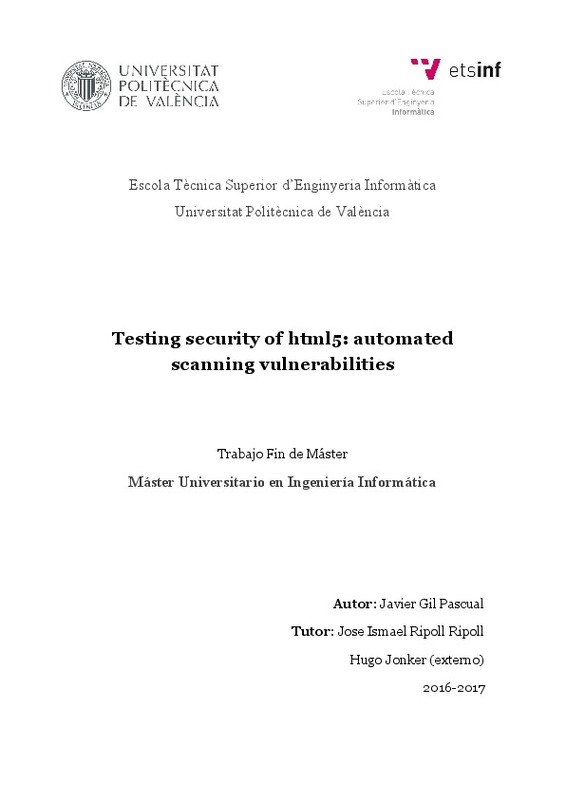JavaScript is disabled for your browser. Some features of this site may not work without it.
Buscar en RiuNet
Listar
Mi cuenta
Estadísticas
Ayuda RiuNet
Admin. UPV
Testing security of html5: automated scanning vulnerabilities
Mostrar el registro sencillo del ítem
Ficheros en el ítem
| dc.contributor.advisor | Ripoll Ripoll, José Ismael
|
es_ES |
| dc.contributor.advisor | Jonker, Hugo
|
es_ES |
| dc.contributor.author | Gil Pascual, Javier
|
es_ES |
| dc.date.accessioned | 2017-12-05T11:44:50Z | |
| dc.date.available | 2017-12-05T11:44:50Z | |
| dc.date.created | 2017-11-13 | |
| dc.date.issued | 2017-12-05 | es_ES |
| dc.identifier.uri | http://hdl.handle.net/10251/92022 | |
| dc.description.abstract | [EN] HTML5 has several new components like XHR-Level2, DOM, Storage. With any major introduction of new features, HTML5 also brings with it potential security vulnerabilities. It allows crafting stealth attack vectors and adding risk to end client. Some originate from elements of the standard itself, some from implementations of the standard in each browser, and some from the care that developers do (or do not) take in building their HTML5 code. . . In this thesis we are going to talk about this new attack surface and possible threats. We are also going to cover how to automatically detect these possible vulnerabilities. This thesis describes a set of HTML5 vulnerabilities, we build a test web and use this for test the capabilities of several open source pen-testing tools. Based on the observed results, further work is also discussed. | es_ES |
| dc.description.abstract | [ES] HTML5 tiene varios nuevos componentes como XHR-Level2, DOM, Storage. Con esta introducción de nuevas tecnologías, HTML5 también lleva consigo potenciales riesgos de seguridad. Algunos originados de los elementos del estándar en sí, otros de la implementación particular del estándar en cada navegador, y otros del cuidado que pongan los desarrolladores a la hora de escribir código. . . En esta tesis vamos hablas de estas nuevas estrategias de ataque y posibles amenazas. También cubriremos cómo detectar estas vulnerabilidad automatizando el proceso. Esta tesis describe una serie de vulnerabilidad web, sobre las que hemos construido unos test para probar las capacidad de algunas herramientas de pentesting. Basándonos en los resultados observados, discutiremos futuros resultados. | es_ES |
| dc.format.extent | 55 | es_ES |
| dc.language | Inglés | es_ES |
| dc.publisher | Universitat Politècnica de València | es_ES |
| dc.rights | Reserva de todos los derechos | es_ES |
| dc.subject | HTML5 | es_ES |
| dc.subject | vulnerabilidades | es_ES |
| dc.subject | pentesting | es_ES |
| dc.subject | crawling | es_ES |
| dc.subject | Web | es_ES |
| dc.subject | Security | es_ES |
| dc.subject.classification | ARQUITECTURA Y TECNOLOGIA DE COMPUTADORES | es_ES |
| dc.subject.other | Máster Universitario en Ingeniería Informática-Màster Universitari en Enginyeria Informàtica | es_ES |
| dc.title | Testing security of html5: automated scanning vulnerabilities | es_ES |
| dc.title.alternative | Testeado la seguridad de HTML5: escaneo automatizado de vulnerabilidades | es_ES |
| dc.type | Tesis de máster | es_ES |
| dc.rights.accessRights | Abierto | es_ES |
| dc.contributor.affiliation | Universitat Politècnica de València. Escola Tècnica Superior d'Enginyeria Informàtica | es_ES |
| dc.contributor.affiliation | Universitat Politècnica de València. Departamento de Informática de Sistemas y Computadores - Departament d'Informàtica de Sistemes i Computadors | es_ES |
| dc.description.bibliographicCitation | Gil Pascual, J. (2017). Testing security of html5: automated scanning vulnerabilities. http://hdl.handle.net/10251/92022 | es_ES |
| dc.description.accrualMethod | TFGM | es_ES |
| dc.relation.pasarela | TFGM\71763 | es_ES |
Este ítem aparece en la(s) siguiente(s) colección(ones)
-
ETSINF - Trabajos académicos [5160]
Escola Tècnica Superior d'Enginyeria Informàtica






